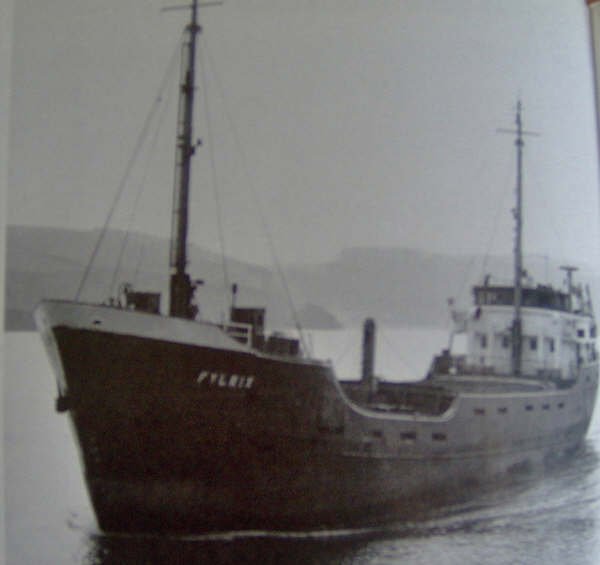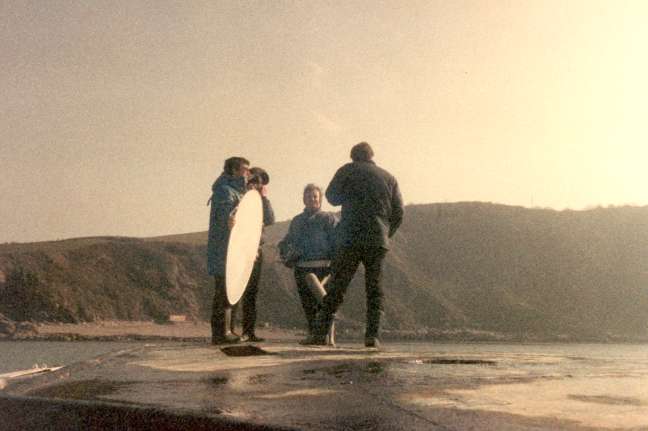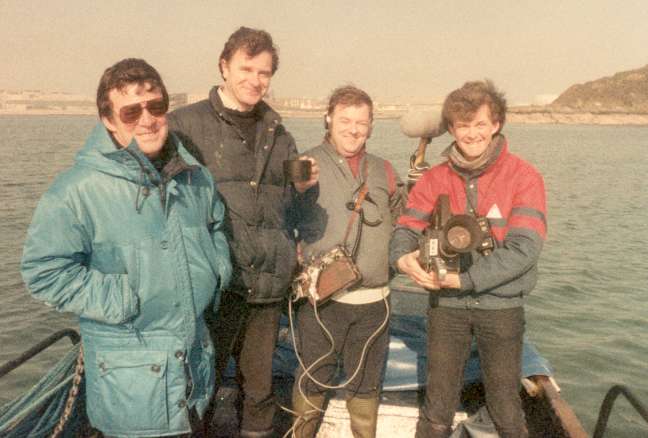Although nobody would wish a ship to be wrecked, I am sure that many of us would admit to feelings of excitement and expectation when one does, especially if it happens right on your own doorstep. Jennycliffe has in the past been the scene of many strandings, and of course more recently the Noordzee lay sunk there for over a year before she was eventually salvaged, much to the disappointment of many local divers.

However, for ships in trouble, Jennycliffe Bay provides a very sheltered anchorage, and with the violent storms that we seem to be experiencing more often nowadays, it was not long before another damaged ship crept into the shelter of Jennycliffe Bay, capsized and promptly sank.

On the night of 21 November 1984 the small cargo vessel Fylrix was on its way from Dean quarry bound for London with a cargo of granite chippings. Whilst off the Eddystone light, some of the cargo shifted and the Fylrix developed a severe list to st’bd; The Master decided to head for the safety of Plymouth, and was escorted into the Sound by a Royal Navy frigate. As the Fylrix approached Jennycliffe the list became much worse and it became obvious to all that the ship would soon sink. In the early hours of the following morning the entire crew abandoned the ship as it started to capsize, and the Fylrix sank in shallow water about one hundred yards offshore.
No attempt was made to salvage the vessel and soon she was declared a constructive total loss. The Fylrix now lies on her st’bd side with her stem pointing towards the shore. At high tide she is completely covered, but at low water her port side is completely clear of the water, and you can get on board by simply stepping out of your boat. It is best to be careful, however as just below the surface is a mass of rigging from the radar mast, and it would be very easy to foul your propellor. On a ship this modern, it comes as a surprise to find that all the portholes are made of brass instead of the more usual steel or aluminium. Some of the portholes are hanging open and so it is very easy just to peer into the cabins, although the portholes are too small to enter the ship by.

If you want to get right inside, simply go to the bridge and drop right through the door. The toilet is on the left, Captain’s cabin to the right. Of course if you wish to go right inside the Captain’s cabin, or the engine room, then you will have to get properly kitted up as snorkeling inside this wreck is definitely not recommended. So what is it like inside? Well it might sound silly but my over riding thought was how clean and tidy everything was. I kept expecting the crew to arrive back at any moment. In fact the Fylrix is the only wreck that I have been on where you think that you are on the film set of the Marie Celeste. In the Captain’s cabin for instance, all the books were on the shelf, bed still made, and photographs still on the walls, sorry bulk- heads. There was even soap and toilet paper in the loo. It was as if everybody had gone out to lunch. Come to think of it I suppose that is exactly what did happen, only nobody ever came back.

On the outside, the wreck is still completely intact right down to her radar. The granite chippings which caused the capsize in the first place are still left inside the holds, so it is not a good idea to go crawling around inside, as the chippings could quite easily move and cover you. Just off the bridge a lifeboat has broken loose from its davit and is only prevented from shooting to the surface by a restraining wire at the top of the winch unit. Over the rest of the seabed are strewn all kinds of debris. Fire extinguishers, hanks of rope, pieces of wire hawser, broken stanchions, and quite a few pieces of crockery. Judging by the number of divers that swarm over the Fylrix at the weekends, I should not be surprised to find lots of diving knives and the odd mask and snorkle as well. Very soon I should think that anything that can be removed will be, and the only thing of value left will be the beautiful bronze propellor.

If only the Fylrix had gone down on the Tinker reef. What a dive she would have made. As it is you have to contend with hordes of divers banging and chipping away, inflate- abIes churning up the water, and curious board sailors bumping into her upturned hull. It is almost as frustrating as a traffic jam. Never mind, in the evening on a high tide when everyone has gone home, you can pretend that the Fylrix is in a hundred feet of water and puzzle out how to lift that beautiful bronze propeller.

Shortly after I took this photo of the Fylrix prop, a very professional ‘team’ snuck down and had it away.
Soon the Fylrix started to break up and after a diver was killed in distressing circumstances, he got lost in the wreck and ran out of air, it was descided to blow it up to disperse the wreck and make it less dangerous.
Today there is still quite a bit left, but its basically now just scrap. The glory days have gone.

Ken Bretherick C/O Fylrix says
I was chief officer of the Fylrix at the time of foundering in Plymouth Sound. The cargo didnot shift as stated but starboard side hatch combings had large holes on the upper side due to corrosion. A large ingress of water gradually increased the list to the point of capsizing, which is the logical slow progress of foundering. I took charge of the vessels’ track to Plymouth Sound due to the Masters’ inability and received praise from coast guards in the handling of this situation. Myself, the master and an engineer remained on board to the end. I had looked at the possibility of beaching the ship on sand to explore the reasons for this damage. Queens harbour master Plymouth informed me of my responsibilities to follow their orders to anchor in Jennycliffe Bay. Plymouth Life Boat took us from the ship and literally 30 seconds later she disappeared beneath the waves! I have many more comments to make on this stranding and would welcome any discourse from interested persons.
The Venerable Ian Watson says
I am very interested to read the account by Ken Bretherick because I was the Acting Mechanic of the Plymouth Lifeboat that night (I was then a clergyman too in Stonehouse, Plymouth, where the crew for the lifeboat lived). I recall that we had received the boat that day from refit and it was in pristine condition until we had to go ‘on the deck’ to rescue Ken and the remaining two crew – the remainder had been taken off by helicopter previously. I would welcome a further discourse.
jeff harrison says
i was one of the abs on the fylrix i was on the ship the night she sank the starbord side dogs on the steel hatch was not tiytend down witch the mate ken was suporst to do so hes no hero
Chris Mills says
We freedived this wreck on the 7/7/13. There is not much left, though there are some bigger pieces of hull to swim under and holes to poke in. Lots of life, including some big congers under the hull plates.
John says
Subsequently a bilge keel sail boat was left high & dry on the hull and a picture published – anyone have an idea where it might be found?
Steve says
I dived this wreck some weeks after it sank whilst on a diving trip out of Bovisand. A lot of the granite had spilled out onto the seabed. The viz was excellent as I remember. Visited Bovisand a couple of years ago and was distressed to see the degree it had been allowed to deteriorate, especially the POP Inn. Many Happy memories and great dives.